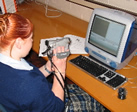Primary 5
Time-lapse videos of human activity are intrinsically appealing and engaging. As they are so seldom used in schools, they have the additional benefit of rarity value.
Broadband connectivity enables schools to access online video materials that can be stored on a teacher's laptop or cached on the school server.
This article describes ways in which a free, high resolution time-lapse sequence can be used to support learning in RE.
The footage shows the weekly process of transforming the Galloway Hall in Preston into the Greek Orthodox Church of the Holy Apostles. The priest and congregation assemble the iconostasis and the many smaller features found in an Orthodox place of worship.
As part of a unit of work on ‘worship’, a Year 5 teacher accessed the flat-pack church resource provided by Cumbria Lancashire Education Online (CLEO). It was used with an interactive whiteboard to explore the key question ‘What is a place of worship?'
With little introduction, pupils were asked to focus on the opening two frames of the resource, which provide a brief statement of what they are going to see and then a question:
Statement: You are about the see a photograph of an empty room.
Question: What do you think you will see when you click the ‘play’ button?
The teacher invited pupils to suggest ideas, and recorded these at the side of the whiteboard for later reference and comparison. Alternatively, pupils could brainstorm ideas in groups and report back to the class. Additional prompt questions were provided by the teacher to increase the scope of the speculation, such as:
What do you think the room is usually used for, and how do you know?
If this were to become a place of worship, what would need to be done to it? (This question draws on prior learning but need not be dependent on pupils having prior knowledge of the Orthodox Christian tradition.)
The pupils then watched the movie and were prompted to look at objects, symbols and where things are placed. The movie is short and focused enough to be shown twice if needed.
Prompt questions include:
What objects and symbols did you notice?
Where were they placed, and what does this tell you about how important they are?
What questions do you have about what you have seen?
What would be a good thing about having to 'make' your place of worship each week and what would be not such a good thing?
Is there anything about which you show this amount of commitment?
During feedback, things on their initial list of speculations were checked off, added to or amended. Pupils were actively encouraged to make links between the things they are committed to and the commitment shown by the Orthodox community in the resource.
The teacher then asked pupils to compose an answer to the key question ‘What is a place of worship?’ Pupils were encouraged to use a combination of writing and illustration to convey their ideas.
A simple recording sheet is available for download (RTF format) from the CLEO website, with a screenshot of the completed room in the centre for pupils to annotate, record discussion points, or draft their answer to the key question.
More resources for exploring Orthodox Christianity
Where the focus of a unit of work is on Orthodox Christianity, work could move into looking at the Orthodox tradition using other free resources from CLEO.
From this, questions could develop about:
the liturgy and the place of worship- how the features of the building embody key theological beliefs
the people- the impact that ways of worshipping and living as a Christian in Britain has on everyday life and decision-making.
This activity provides opportunities for pupils to:
answer the question ‘What is a place of worship?’, referring to examples from one or more religions studied, using general words like ‘worship’, ‘community’ and ‘belong’ (attainment target 1, level 3)
begin to identify the impact religion has on believers’ lives (attainment target 1, level 3)
ask good questions about why worshippers choose to attend a place of worship (attainment target 2, level 3)
make a link between their own idea of commitment and that shown by the members of the Holy Apostles Orthodox Church (attainment target 2, level 3)
develop the skill of speculation, an important skill in RE.
How ICT enhanced teaching and learning
ICT gave ready access to an unusual resource that provided a more dynamic and engaging stimulus to learning than more traditional resources for this topic.
ICT brought into the classroom a religious tradition that pupils in many parts of the UK would not be able to access in any other way.
Pupils were immediately and sharply focused on the resource, so they engaged with the learning objective of the lesson.
The resource is short and focused enough to be shown twice or more, where this is helpful to pupils.
Related Resources on the Becta website

